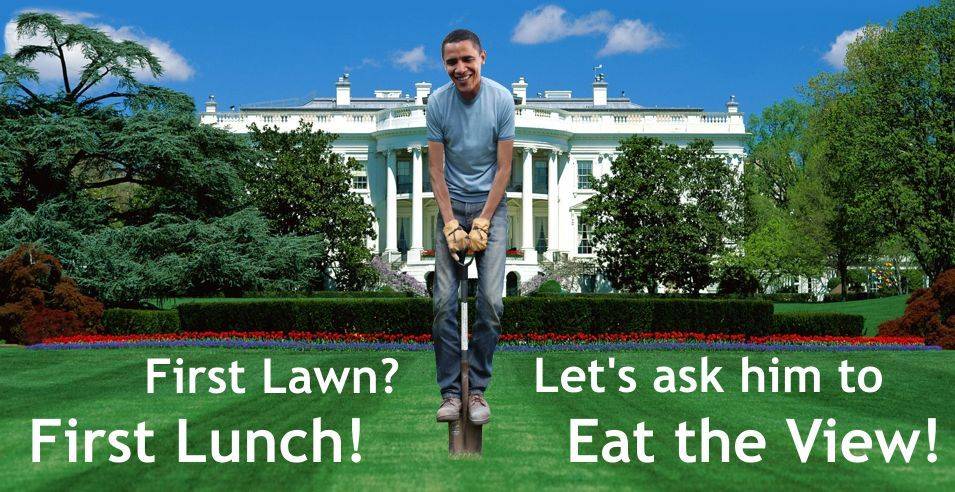 “1500 Miles / 400 Gallons / SAY WHAT?” reads the handmade sign in Roger Doiron’s yard. From Scarborough, Maine, 41-year-old Doiron is the founder of nonprofit organization Kitchen Gardeners International, started in 2003 as a virtual community for gardeners around the globe. KGI is part of the locavore movement — encompassing those who think globally, but eat locally.
“1500 Miles / 400 Gallons / SAY WHAT?” reads the handmade sign in Roger Doiron’s yard. From Scarborough, Maine, 41-year-old Doiron is the founder of nonprofit organization Kitchen Gardeners International, started in 2003 as a virtual community for gardeners around the globe. KGI is part of the locavore movement — encompassing those who think globally, but eat locally.
Doiron’s yard sign refers to the average distance food travels from field to fork and the gallons of oil used to feed one person for one year. Michael Pollan, an author, writer for The New York Times and Knight Professor of Journalism at the University of California, Berkeley, published a letter to the new president-elect last October (read the letter here). Pollan expands upon the current food crisis, linking food production and consumption to the problems of health care, energy dependence, climate change and national security.
In response to the complex problems associated with modern, industrialized food production, locavores are encouraging people everywhere to grow food, not grass. They are proposing that urban green spaces, residential yards and even schoolyards be transformed into edible landscapes. Last February, Doiron, who sets an example with edible landscapes in both his front and back yards, gave his first pitch for the now widely-known Eat the View campaign, which is asking the Obama family to reestablish a vegetable garden on the White House lawn. Below is a summary of Doiron’s proposal, taken from the website OnDayOne.org:
Announce plans for a large organic Victory Garden on the First Lawn with the produce going to the White House kitchen and local food pantries. The White House is “America’s House” and should serve as a model at a time of economic and environmental crisis. President-elect Obama would not be breaking with tradition, but returning to it (the White House has had food gardens before) and leading by personal example on global challenges such as food security, climate change and energy independence.
John Adams, the first president to live in the White House, maintained a vegetable garden that fed his family. During World War I, President Woodrow Wilson and his wife, Edith, reduced yard-related fuel and labor expenses by allowing sheep to graze on the White House lawn. Edith Wilson also planted a vegetable garden, initiating the Liberty Garden (later called Victory Garden) campaign. With substantial success, Eleanor Roosevelt reintroduced the Victory Garden idea following Pearl Harbor in the 1940s. Roosevelt, despite objections from the USDA, planted a garden in front of the White House in 1943. The American people followed her lead, and by the end of World War II in 1945, Victory Gardens were generating 40 percent of our nation’s produce.
Food production changed dramatically following World War II. The munitions industry transformed into the fertilizer industry, and the government began subsidizing commodity crops, such as corn, soybeans, wheat and rice. With subsidies, food could be sold for less than the cost to grow it. This artificially cheap grain also made feedlots viable, allowing farmers to feed cattle more cheaply and driving down the cost of meat. With the development of interstate highways and national trucking networks, as well as the provision of cheap energy, we began transporting foods across the globe. All of this has led Americans to consume falsely affordable — but not necessarily fresh, nutritious or cost effective — foods.
As we endure the Iraq War and enter crises of many kinds — food, financial, energy, environmental — it is time to resurrect the Victory Garden model. It is time to transform at least a portion of the 18-acre White House lawn and the 23 million acres of lawns throughout America. It is time to take steps toward solving our crises by returning to a localized, sustainable way of living. It is time to declare victory over high food prices, poor diets and dependence on foreign oil. And what better way to do this than with a garden on the White House lawn when President-elect Obama takes office this week? As many have pointed out, this is neither a conservative nor liberal issue, but should be important to anyone who wants to enhance the welfare of their family and their environment.
This Lawn is Your Lawn – 1 minute version for Climate Matters contest from roger doiron on Vimeo.
Visit the Eat the View website to learn more and to sign the petition, which will be delivered to President Obama with packets of heirloom seeds. And here in C-U, I invite you to dream. What if we all had Victory Gardens (either on our lawns or in pots and window boxes)? What if our farmer’s market continued throughout the winter, providing local produce all year long? What if our children were helping maintain vegetable gardens on school premises, learning to grow their own food and eating that produce in their school cafeterias? What if …?








